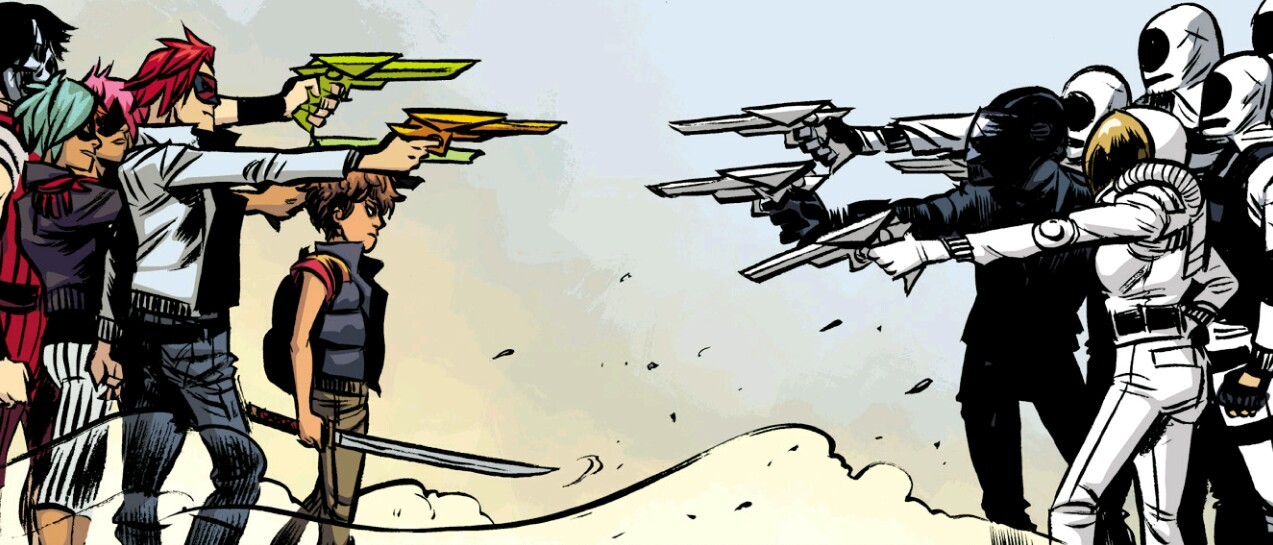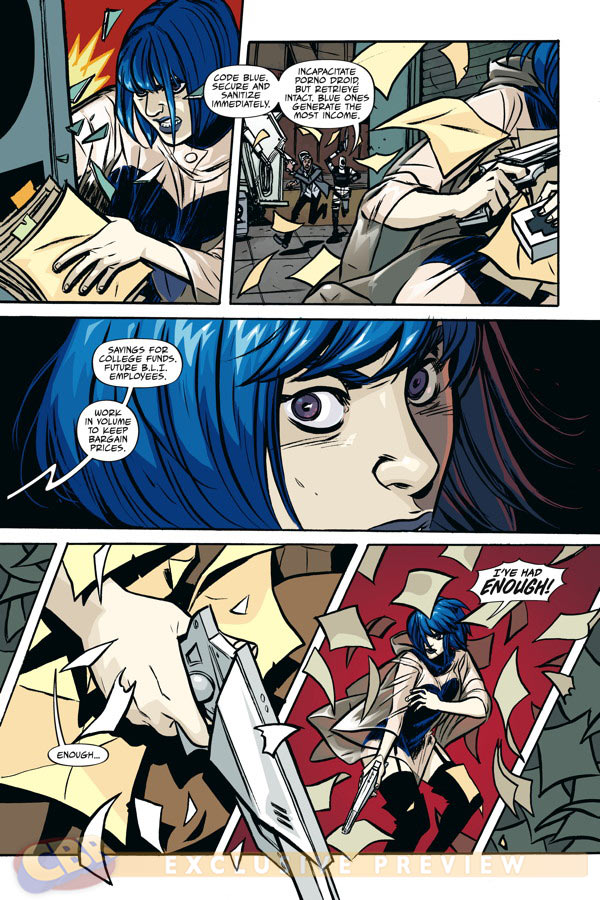
The True Lives of the Fabulous Killjoys (2014)
Grab your friends
And hold them close.
‘Cuz we got no time for heroes
And no room for ghosts.
So sayeth colorful radio personality Dr. Death-Defying, our de facto narrator and first introduction into The True Lives of the Fabulous Killjoys, a fantastic comic adventure birthed from the minds of Gerard Way (former frontman of the dearly departed My Chemical Romance) and Shaun Simon. Conceived as a companion piece to MCR’s sprawling 2010 concept album of the same (well, similar) name, Killjoys chronicles the exploits of the titular group as they survive in the wasteland of a dire future California. Way, who first cut his comic book teeth on the excellent Umbrella Academy, delivers again here with a snappy, stylish take on modern youth culture-as-apocalyptia, supported by the colorful and kinetic artwork of Becky Cloonan (probably best known for her standout work on titles like Conan and Batman).
Killjoys takes place in 2019 California, where civilized society as a whole has collapsed into warring factions of chaos and order. The book splits its time between two distinct locales – the Wasteland, populated by drifters, outcasts, monsters, and vigilantes — and Battery City, a stark, totalitarian megalopolis, run by the shady Better Living Industries. The story arc of the series is pretty standard sci-fi fare. Charismatic outlaws and a “Chosen One” band together to overthrow an overtly evil regime. Along the way we meet a variety of interesting characters, including: a pair of Porno Droids (life-like sex worker automatons) on the run from the BLI; Cherri Cola, a washed-up assassin who takes the mysterious Girl under his wing; the deadly Korse, a BLI-controlled contract killer that is hiding a life-jeopardizing secret; and the aforementioned Dr. Death-Defying, a paraplegic war veteran who runs a wasteland radio station. The large cast of characters helps to flesh out the story’s universe and give it an epic feel.

Art by Becky Cloonan.
Frankly, though, the real strengths of Killjoys do not lie within its interesting but ultimately generic plot. Obviously fans of style-as-substance, Way and Simon do a fantastic job with the scripting and dialogue, which is always snappy and informal. They manage to avoid giving large exposition dumps by letting the characters converse naturally and trusting the reader to catch up by taking context cues from the story. It definitely requires a little more concentration on the part of the reader – while the majority of the dialogue is made up of familiar words, the cadence and delivery are alien enough to convincingly illustrate a culture far-removed from our own. Furthermore, the hidden strength of the writing is that the whole of the comic book works as a clever allegory for today’s youth, who are coming of age and finding that the world that should be entrusted to them is instead being mishandled and mistreated by the previous generation. I think it’s hard to be a Millennial right now and not feel at least a little sense of disillusionment, and Way and Simon find a way to tap into that latent frustration and spin a fantastical, yet familiar, story.

Art by Becky Cloonan.
The secret weapon of Killjoys is clearly Becky Cloonan, however. Her bold, evocative art style portrays dense settings, well-defined characters, and action scenes without ever looking cluttered or confusing. She does a fantastic job of differentiating between the Wasteland and Battery City; where the former is run down and painted with bright colors, the latter is stark, sterile, and monochromatic. Without ever paying direct lip service to other works, the Wasteland clearly evokes the run-down worlds of The Road Warrior or Fallout. While spending time in Battery City, on the other hand, I couldn’t help but be reminded of Blade Runner, especially in the portrayal of androids as basically human. It’s a testament to Cloonan’s confident handiwork that the artistry is fun and engaging while still conveying the menace and danger in the plot proceedings.

The original Killjoys. Art by Becky Cloonan.
My Chemical Romance’s Danger Days: The True Lives of the Fabulous Killjoys was a sprawling, epic rock opera that introduced the merry band of warriors known as the Killjoys. The album told the story of Party Poison, Jet Star, Fun Ghoul, and Kobra Kid as they took the fight to Better Living Industries and cemented their place as legends. The music videos that accompanied the album illustrated key moments in the story and introduced ancillary characters that ended up starring in the comics, primarily Korse and the Girl. Interestingly, Way wanted the comics to not be an adaptation of the album (which would have been cool in its own right), but rather a continuation of it. It’s rare to see an album so well-conceptualized that it creates a universe that can support spin-offs and sequels that transcend its medium. The fact that The True Lives of the Fabulous Killjoys does it with such aplomb makes me sad to see the story end.
[youtube http://www.youtube.com/watch?v=egG7fiE89IU]
All six issues of The True Lives of the Fabulous Killjoys are available now in a collected edition from Dark Horse Comics.



That art is amazing, you have totally sold me on checking that out.